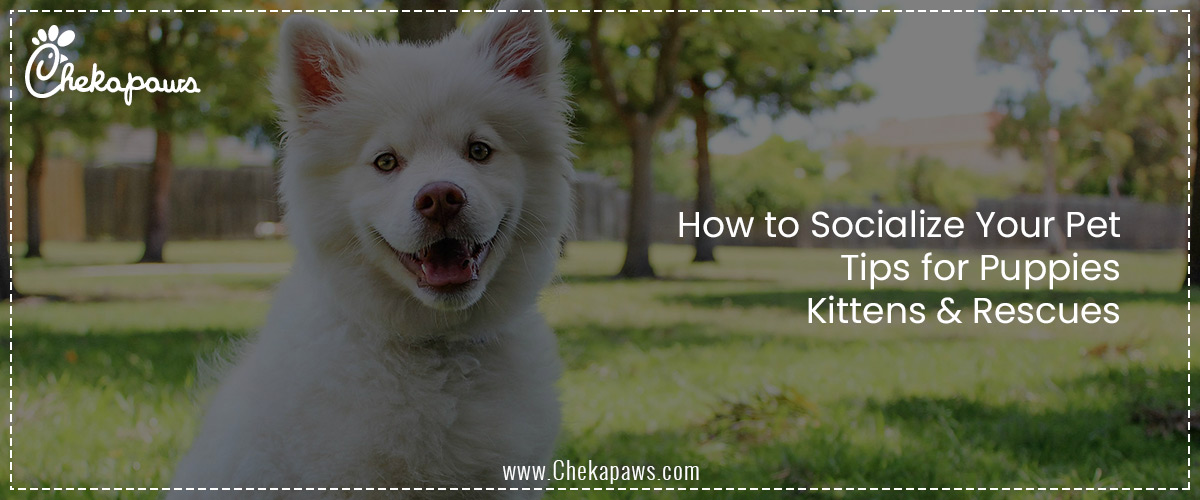One of the most important parts of growing a well-behaved pet is socialization. The socialization process helps in the development of positive connections between your pet and people, other animals, and other situations, regardless of whether it is a puppy, kitten, or rescue animal. Pets who are not properly socialized may develop anxiety, fear, or even aggression. To prevent the pet from being overstimulated, keep socialization sessions brief and frequent. We’ll go over the best ways to socialize puppies, kittens, and rescues in this full guide to make sure they become comfortable and optimistic pets.
Table of Contents
The Significance of Socialization
Socialization is important for the following reasons:
- Minimizes stress and anxiety
- Promotes positive interactions between people and their pets
- Prevents behavioral issues such excessive shyness and dislike.
- Helps pets in adjusting to different settings, noises, and situations
- Strengthens the owner-pet relationship
When to Start Socializing Your Pet
- The age and background of the pet determine the most suitable time to begin socialization.
- Puppies: The most suitable time frame for puppies is from three to sixteen weeks of age.
- Kittens: The kittens primary socialization phase starts from two to nine weeks of age.
- Rescue pets’ socialization is impacted by their trauma and prior experiences. Helping a rescue pet get used to new situations is always doable, even though it can require extra patience.

Socializing Puppies
Early Socialization Stages
1. Introducing New People
- Introduce your puppy to plenty of people, such as kids, the elderly, and those with uniforms, hats, or glasses.
- To help them adjust, encourage gentle handling and petting.
- Use toys to help your pet improve motor skills and build pleasant interactions.
2. Exposure to Different Environments
- Take your puppy on park walks, vehicle rides, and shopping at pet-friendly places.
- Introduce a number of surfaces, including pavement, sand, and grass.
3. Meeting Other Pets
- Arrange up monitored playdates with friendly, vaccinated dogs.
- In a supervised setting, introduce your puppy to other pets, such as cats or other small pets.
4. Handling and Grooming
- Get your puppy used to being touched, including paws, ears, and tail.
- Reduce their anxiety about grooming by routinely brushing their fur, checking their teeth, and cutting their nails.
Positive Reinforcement and Training
- Give them treats and praise if they behave in a calm and trustworthy way.
- In order to guide interactions, use a leash and harness.
- Introduce new experiences gradually and in a constructive way.

Socializing Kittens
Early Socialization Stages
- Handling and Human Interaction
- Every day, handle and hold your kitten gently.
- Allow them the opportunity to interact with others by introducing them to new people.
2. Exposure to Household Noises
- To help them get used to loud different noises, gradually introduce everyday sounds like vacuum cleaners, televisions, and washing machines.
3. Meeting Other Pets
- Introduce your other pets gradually at first using a barrier if you have any.
- Give them praise for good behavior and separate them if they don’t behave well.
4. Encouraging Play and Exploration
- Provide interactive toys, tunnels, and cat trees.
- Allow exploration in a secure environment.
Training and Positive Reinforcement
- Treats and Praise can be used to promote social behavior.
- Let the kitten come at their own pace; never force encounters.
- Play frequently to develop confidence and trust.
Socializing Rescue Pets
Understanding Their Background
- Examine the pet’s comfort level, fears, and past experiences.
- If necessary, seek advice from an animal behaviorist or veterinarian.
Building Trust Gradually
- Establishing a Routine
- Keep your play, walking, and feeding schedules regular.
- When interacting, maintain composure and patience.
2. Introducing New People and Pets
- Before interacting them with other pets or other people, let the pet watch from a safe distance.
- To create positive associations, use rewards and positive criticism.
3. Creating Safe Spaces
- Avoid overwhelming them with too much stimulation too quickly.
- Give a space where the pet can feel safe.
- Create a cozy atmosphere with beds, blankets, and calming fragrances.
4. Reduced Sensitivity to Triggers
- Introduce the pet gradually to things that make them anxious, such as loud noises or unfamiliar people.
- To change how they react to these signals, use counter-conditioning.
- Provide relaxing tools like pheromone diffusers or soothing snacks.
Long-Term Socialization Strategies
- Throughout your pet’s life, keep introducing them to new things.
- If required, sign up for socialization or training courses.
- Keep an eye on body language and adjust interactions as necessary.
- To reduce stress, introduce leashes to dogs gradually.
- Regularly participate in reward-based training and interactive play.
Typical Socialization Mistakes to Prevent
- Rushing the Process: Let your pet get used to things at their own speed.
- Applying Punishment: Anxiety and terror can be increased by negative reinforcement.
- Ignoring Early Socialisation Windows: Behaviour is largely shaped over the first several months.
- Encouraging Interactions: Allow your pet to willingly engage in novel circumstances.
- Lack of Consistency: Successful socialisation requires frequent exposure to novel situations.
Conclusion
It takes time, perseverance, and positive reinforcement to successfully socialize your pet. A lifetime of confidence and companionship may be established by taking the time to gently and methodically expose your pet to the outside world, regardless of whether they are a playful puppy, an inquisitive kitten, or a rescue animal with a challenging past. Get your pet socialized now and reap the rewards of having a well-behaved pet!







